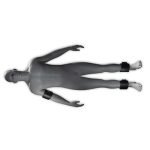Pulse Wave Analysis (PWA)
Pulse Wave Analysis (PWA) serves as a diagnostic method for evaluating the state of the cardiovascular system. This entails ongoing examination of arterial blood pressure (ABP) and the pulse pressure waveform. The pulse pressure wave is shaped through the mixture of the direct systolic wave and waves reflected back from the periphery.
Basically, there are 2 parameters related to Pulse Wave Analysis.
Central systolic blood pressure (SBPao) is described as the highest pressure observed in the aorta when the heart contracts, pushing blood from the left ventricle into the aorta. It offers a more direct indication of the hemodynamic load on the heart and brain than the brachial systolic blood pressure (SBPbr). Moreover, research studies demonstrate that SBPao is a stronger predictor of cardiovascular events than SBPbr.
The augmentation index (AI) is an indirect way to measure how stiff the arteries are, and its value tends to increase as a person gets older. The Augmentation Pressure (AG) is calculated based on the difference of the direct (forward) pressure wave (generated by the left ventricular ejection) and a reflected wave, created by the impedance differences along the peripheral arteries.
Utilizing Pulse Wave Analysis Parameters in Clinical Routine
In medical science, parameters are the most important components of any analyses and consequently any treatments. 15 different parameters can be measured and analysed by Arteriograph and Arteriograph 24. The value of Pulse Wave Analysis (PWA) has been proven in many clinical conditions, such as coronary artery disease (CAD), congestive heart failure (CHF), hypertension, diabetes and preeclampsia.
How does Arteriograph perform a Pulse Wave Analysis?
Arteriograph measures the first and the reflective pressure waves precisely. But the measured data needs to be interpreted and different markers will be concluded from them. This process is the base of pulse wave analysis.
Processing raw data obtained by Arteriograph can be done by the specialised software through series of evaluations. The result will be represented as pulse wave analysis and include various information.
Through pulse wave analysis, one can evaluate the relation of two waves together, the intensity and time difference between them and can conclude several physiologically important data, each explaining a specific phenomenon.
In the following section you can access the two main parameter groups resulting from pulse wave analysis: Augmentation Index (AIx) & Central Systolic Blood Pressure, and Aortic Pulse Wave Velocity (PWVao), measured separately by the devices of TensioMed Ltd. Furthermore, other informative parameters of pulse wave analysis can come in handy to gain a comprehensive view of the patient’s central hemodynamic state.

Aortic Pulse Wave Velocity (PWVao)
Pulse Wave Velocity is an indicator of arterial stiffness, it measures the speed of pressure wave propagation along the aorta. This phenomenon totally depends on physical characteristics of aortic wall.

Central Blood Pressure (SBPao)
Unlike brachial systolic pressure, this parameter can provide information regarding one of the most important datasets in pulse wave analysis known as the reflective pressure wave. This wave is the basis of every calculation to collect data about the central hemodynamic state.

Ankle-Brachial Index (ABI)
Ankle Brachial Index is the great determinant of peripheral artery diseases. it can be described as the ratio of systolic blood pressure in the upper toward the lower limbs.

Augmentation Index (AIx)
Total peripheral resistance (TPR) is controlled by diameter of peripheral arteries which is determined by endothelial function. Upon vascular damage, endothelium loses its ability to produce nitrogen-monoxide (NO) leading to higher TPR, thus, stronger reflective pressure wave and increased Aix.

Other Central Parameters
Ankle Brachial Index is the great determinant of peripheral artery diseases. it can be described as the ratio of systolic blood pressure in the upper toward the lower limbs.

Clinical usage
If you require more information, please visit "Arteriograph Clinical Usage" sub-page.
However, the examination of the above-mentioned parameters has not yet become part of the daily routine in clinical work, the new non-invasive measurement technology, the Arteriograph offers a solution to eliminate the difficulties in detecting pathological central hemodynamic changes in hypertension, atherosclerosis, congestive heart failure (CHF), coronary artery disease (CAD), diabetes, preeclampsia and chronic kidney diseases (CKD).



